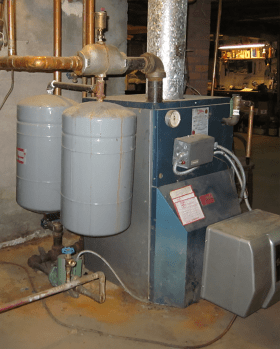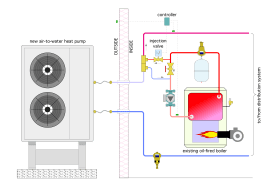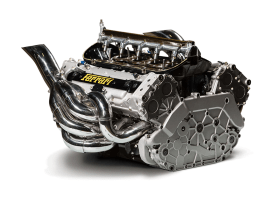Hydronic heating systems have been in use since the late 1800s. Like most technologies, the methods and materials used in these systems have continually advanced.
In the early 1900s, a new hydronic system likely burned coal in a cast iron boiler to heat the water to 190ºF or higher. It relied solely on the buoyancy of that water to carry heat to cast iron radiators. Although circulators were still several decades away, a rudimentary system, such as shown in figure 1-1, was able to move heat to where it was needed, even in multi-story buildings.
Today, a new hydronic system is likely to have a modulating/condensing boiler or heat pump as its heat source and may only heat water to 110ºF. Several components in the system, including the controls, the heat source, and the circulator(s), use microprocessor-based electronics to direct heat exactly where it’s needed in a building, while optimizing fuel and distribution efficiency.
WHAT’S AHEAD?
There are an estimated 6 million hydronically heated homes in the United States. The vast majority of those systems have a boiler operating on fossil fuel as their heat source. Many of the systems that were installed 40+ years ago are likely operating with high supply water temperatures in the range of 160-200ºF. This was common practice when fuel was relatively inexpensive, and the efficiency of converting that fuel into heat was not a top priority. Higher water temperatures also allowed for smaller heat emitters, which reduced installation cost.
As this issue of idronics is being written, global energy markets are changing rapidly. Social and political forces are incentivizing the use of electricity as a replacement for fossil fuels in a wide range of applications, including building heating. This trend is largely based on projections that electricity will be increasingly supplied by renewable sources, such as utility-scale solar photovoltaic systems, wind turbines and hydroelectric facilities.
These changes in energy markets will significantly alter the future of hydronics technology. Mechanical codes and other government regulations will increase the minimum acceptable thermal efficiencies of all hydronic heat sources. The price of fossil fuels is also likely to increase based on market demand, as well as directives such as carbon taxes.
Air-to-water heat pumps, as well as geothermal water-to-water heat pumps, will be increasingly used as heat sources for hydronic-based systems. In many retrofit situations, these heat pumps will be combined with an existing boiler, such as shown in figure 1-3. The heat pump serves as the primary heat source. The existing boiler serves as the supplemental and backup heat source.
Conventional boilers designed to operate without sustained flue gas condensation, and having maximum thermal efficiencies in the mid-80% range, are likely to be limited to very specific applications, such as for steam production.
Depending on current and pending regulations, boilers used in future hydronic heating systems may be limited to those operating on electricity or a renewable fuel source, such as biogas, biodiesel, biomass (primarily wood-based) or hydrogen.
These changes will create many opportunities for transitioning an existing hydronic heating system supplied by a conventional boiler to a contemporary heat source, such as a hydronic heat pump or modulating/condensing boiler.
Some of these opportunities will be based on the existing boiler reaching a condition where keeping it in operation is impractical, impossible or even illegal. Others will arise from the owner’s desire to reduce their carbon emissions by eliminating their existing fossil fuel boiler. Still others will be driven by the changing economics of fuel options.
ESTIMATING vs. GUESSING
Imagine someone who wants to build a race car. They’ve done research and determined that engines built by Ferrari offer excellent performance, so they make a major investment and purchase a 10-cylinder, twin-turbocharged Ferrari engine capable of delivering over 700 horsepower. The engine arrives and gets installed in the vehicle shown in figure 1-6.
Do you think this combination will result in a high-performance race car?
It’s very unlikely that the transmission in the 1957 Chevrolet could utilize the horsepower the Ferrari engine can deliver. The car’s body shape is also poorly matched to the expectation of a vehicle that can cruise at speeds over 200 mph. In short, this is a very poor matching of an energy source (the engine) with a “balance-of-system” (the car body and transmission). The performance of such a matching would be far from optimal.
Although most readers recognize this as a far-fetched combination, it’s analogous to installing a high-performance hydronic heat source, such as an air-to-water heat pump or mod/con boiler, into an existing hydronic distribution system that was never intended to operate at conditions that would optimize the performance of that heat source.
Professionals who design racing vehicles would never “guess” when it comes to matching an engine to a chassis, transmission or body. They would make calculations or perform tests and simulations to study the potential matchup.
In a similar manner, HVAC professionals need to study the potential matching of a high-performance heat source with an existing distribution system. In doing so, they can identify potential problems or performance deficiencies before committing to a specific design.
Simply removing the existing boiler and installing the new heat source, without understanding how it will interact with the existing distribution system can lead to problems such as:
- Short cycling of the new heat source
- Insufficient heat output in some areas of the building
- Inadequate flow rate to maintain proper operation of the new heat source
- Seasonal energy use that is much higher than anticipated
- Damage to the new heat source
- Premature failure of the new heat source
- Dissatisfied customers
This issue of idronics provides HVAC professionals with methods for evaluating the performance of existing hydronic heating systems. It begins with a discussion of different types of heat emitters and how their thermal performance varies with water temperature. It then presents relatively simple procedures for measuring temperatures and flow rates in existing hydronic circuits. It shows how to use those measurements to estimate the performance of the circuit over a range of operating conditions — such as at lower supply water temperatures. The latter serves as a starting point for evaluating the performance of those circuits with new heat sources. The issue concludes with a discussion of several design considerations when transitioning an existing distribution system to a new heat source.







